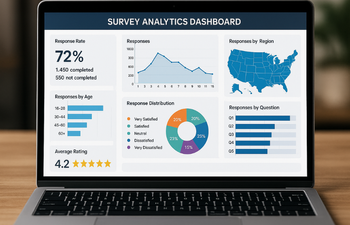Survey Mistakes I Made, and What I’d Do Differently Next Time
Discover common survey mistakes, learn how to avoid them, and enhance your research with actionable tips, strategies, and best practices for better results.

Introduction
Running surveys seems straightforward, ask a few questions, collect answers, analyze the results, and voilà: insights. At least that’s what I thought when I embarked on my first few surveys. But as I dug deeper, it became clear that crafting a good survey is more of a science than an art. The mistakes I made taught me painful but powerful lessons. If I had to do it again, there’s plenty I’d change. This post outlines the blunders I made and what I’d do differently next time so you don’t have to learn the hard way.
Not Defining Clear Objectives
One of the most foundational errors I made was jumping into survey creation without having a clear objective. What did I want to know? Why was this data important? How would I use it? These were questions I ignored at my own peril.
Having vague goals led to a disorganized questionnaire, which in turn yielded scattered responses that were hard to analyze. Clear objectives are the backbone of effective surveys.
Overloading the Survey with Questions
Eager to collect “all the data,” I crammed my first survey with over 50 questions. That was a disaster. Respondents got tired, bored, and dropped off halfway. The completion rate tanked, and the few who finished were likely clicking through just to get it over with.
Next time, I would keep it concise and focused. Prioritize quality over quantity.
- Limit to 10–15 questions max
- Group questions by topic
- Eliminate redundant items
Asking Leading or Biased Questions
I didn’t realize how subtle bias could be in survey questions. One of my questions read:
“How satisfied are you with our excellent customer support?”
That’s a leading question, subtly nudging the respondent toward a positive answer. Rephrasing for neutrality:
“How would you rate your experience with our customer support?”
This can make a huge difference in getting honest feedback.
Ignoring the Target Audience
I crafted questions from my perspective, not the users'. This misstep caused confusion and irrelevant answers. Different audiences have different contexts, languages, and expectations.
Now, I always:
- Define the user persona
- Match tone and language accordingly
- Conduct a few test runs to catch misinterpretations
Poor Timing of Survey Distribution
Timing is everything. I once sent a survey during a holiday weekend and got a 12% response rate. Most of my target audience was offline, spending time with family.
Better timing would have meant launching mid-week, avoiding holidays, and considering time zones.
Neglecting Mobile Optimization
More than half of the respondents accessed the survey via mobile, but I hadn’t optimized the form. Long paragraphs, tiny buttons, and broken formatting ruined the experience.
Lesson learned: Always test your survey on multiple devices before launch.
Skipping Pilot Testing
A pilot test could have saved me from many of the earlier mistakes. But in my initial rush, I skipped it. This oversight led to broken logic flows, ambiguous questions, and formatting glitches.
Pilot testing allows:
- Catching technical errors
- Understanding if questions make sense
- Gathering early feedback
Forgetting to Thank Respondents
Not thanking respondents made the survey feel transactional and impersonal. Adding a simple “thank you” message not only boosts goodwill but also encourages future participation.
Next time, I’ll include a personalized thank-you screen and maybe even a small incentive.
Lack of Incentives
My first few surveys had no rewards or recognition, which led to abysmally low participation. While not all surveys require incentives, offering something, like a discount code, entry into a draw, or early access, can dramatically improve response rates.
Failing to Analyze Open-Ended Responses
I initially ignored open-ended responses because they were harder to analyze. That was a mistake. Some of the richest insights came from those text-based answers.
I now use tools like thematic coding and natural language processing to extract themes and sentiments.
Misinterpreting the Data
I once drew conclusions that the data didn’t actually support. I cherry-picked results to confirm what I hoped to find. That’s a big no-no.
Now, I:
- Cross-tabulate data
- Look for statistical significance
- Involve a second analyst to minimize bias
Overreliance on Quantitative Data
Numbers are powerful, but they can’t tell the whole story. I overlooked the qualitative side, why people responded a certain way.
Pairing quantitative scores with follow-up qualitative feedback offers a complete view.
Using the Wrong Survey Platform
Initially, I chose a platform just because it was free. But it lacked skip logic, export tools, and mobile responsiveness. It cost me more in time and frustration than I saved in dollars.
Next time, I’ll compare platforms based on:
- Features
- Integration capabilities
- UX and analytics
No Follow-up After the Survey
Another error? Silence post-survey. No updates, no shared results, no action plans. This left respondents feeling unheard.
A follow-up message sharing what was learned and what changes will be made builds trust and credibility.
Not Segmenting the Responses
Lumping all responses together gave me a blurry picture. Segmenting by age, role, or region would have revealed trends and differences I missed.
Segmentation is key for deeper insights and actionable strategies.
For tips on improving response rates, see How to Boost Your Survey Response Rate: 7 Proven Tips.
Skipping Accessibility Considerations
One mistake I overlooked was accessibility. No alt text, no screen reader optimization, and confusing color contrasts alienated some users.
Now, I follow WCAG guidelines for inclusive design.
Collecting Unnecessary Personal Data
Initially, I collected emails and demographics “just in case”. That turned away privacy-conscious users. Worse, I wasn’t compliant with GDPR.
Collect only what’s essential and always disclose how the data will be used.
Inconsistent Scales Across Questions
I used different scales (1–5, 1–7, Strongly Disagree to Strongly Agree) inconsistently. This confused respondents and made comparison difficult.
Standardizing the scale ensures clarity and eases analysis.
For strategies to combat survey fatigue, check out Survey Fatigue Is Real: How to Spot It and What You Can Do About It.
Ambiguous Wording
Some questions I wrote were vague or had double meanings. Clarity is critical in surveys. If a question can be interpreted in more than one way, it will be.
I now test every question for:
- Simplicity
- Specificity
- One interpretation only
Poor Survey Flow
Jumping from one unrelated topic to another caused frustration. I didn't think about narrative or cognitive flow.
A logical sequence improves respondent experience:
- Start easy
- Group related topics
- Finish with open-ended or optional questions
Ignoring Survey Fatigue Signals
High drop-off rates at question 12? That’s a fatigue signal I ignored. I should have revised length or added progress bars to help users pace themselves.
Next time, I’ll watch the analytics closely and adapt quickly.
Focusing Only on Positive Feedback
It’s tempting to highlight praise and ignore criticism. I did that once and missed crucial areas needing improvement.
Constructive criticism is more valuable for growth than flattery.
Survey Mistakes I Made
Reflecting on it all, I made nearly every rookie mistake possible. But those experiences became stepping stones to better research practices. With every flawed survey came a deeper understanding of what makes them effective.
Each mistake pushed me closer to becoming more intentional, empathetic, and analytical in my approach.
What I’d Do Differently Next Time
If I could go back and redo my early surveys, here’s what I’d do:
- Start with a clear goal
- Write neutral, simple questions
- Limit the length
- Test on all devices
- Pilot test thoroughly
- Include thoughtful incentives
- Follow up with respondents
- Analyze both numbers and narratives
Ultimately, surveys are about listening, truly, actively, and respectfully.
Conclusion
Surveys are powerful tools, but only when wielded wisely. My early missteps were tough lessons in empathy, strategy, and design. But the beauty lies in growth. The next time you send a survey, may you do so with clarity, precision, and a deeper respect for the people behind every click.
Frequently Asked Questions
Find answers to the most common questions about this topic
Common mistakes include unclear questions, biased wording, poor timing, and ignoring data analysis best practices.
Use clear, neutral language, avoid leading questions, and keep them concise and relevant to the research goals.
Timing affects response rates and the quality of answers. Avoid holidays, weekends, or times of high distraction for your audience.
Platforms like Google Forms, Typeform, and SurveyMonkey offer templates and analytics to minimize errors.
Sample size depends on your goals, but typically, a statistically significant sample for general insights ranges between 100–1000 respondents.
Use both quantitative and qualitative methods, clean your data, and apply statistical or thematic analysis depending on your goals.








